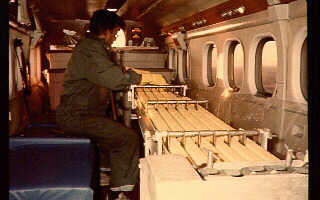Additional vaccinations in Maine and New Hampshire are recommended before backtracking to address disease in infected states
By Roger Segelken

The northward spread of raccoon rabies can be halted by vaccination barrier zones, veterinarians and wildlife biologists at the Cornell University College of Veterinary Medicine are predicting.
A preliminary assessment of vaccine trials in New York, Vermont and Ohio, where oral vaccines are dropped from aircraft into raccoon rabies-free areas, points to the barrier zone strategy as the most promising way to prevent further spread of the disease, the Cornell experts say. But the vaccination barrier should be extended across northern New Hampshire and Maine, they recommend, before treating East Coast states that already are infected with wildlife rabies.
"The vaccination barriers appear to be holding," said Donald H. Lein, D.V.M., Ph.D., director of the Diagnostic Laboratory at the Cornell University College of Veterinary Medicine, where the anti-rabies campaign for the Northeast is based. "We're ready to establish the same kind of barriers in Maine and New Hampshire. This problem calls for a regional approach, because sick raccoons don't stop at state lines."
Or at international borders, either. That's why Ontario and other Canadian provinces are interested in aiding the U.S. anti-rabies effort, said Laura L. Bigler, Ph.D., coordinator of the Cornell vaccination program. A parallel effort to vaccinate Canadian foxes has all but eliminated fox rabies from southern Ontario, Bigler reported. Ontario and Quebec have provided financial and in-kind assistance to the Cornell project in hopes of keeping raccoon rabies from spreading across the U.S.-Canada border and infecting Canadian raccoons.
The Cornell wildlife rabies control program uses an oral rabies vaccine, Raboral, that was fully approved earlier this year by the U.S. Department of Agriculture's Center for Veterinary Biologics. Capsules of the vaccine are concealed in flavored baits that are dropped from aircraft or distributed by hand in populated areas. Besides raccoons, the same vaccine has been shown to control rabies in coyotes as well asred and gray foxes.
Cooperation of several federal, state, county and provincial agencies was required to initiate the rabies-control programs in strategic regions of New York and Vermont. Beginning in 1995, Cornell developed a regional rabies-control strategy for raccoons in the Northeastern United States.
A vaccination zone also has been established in Ohio, said Bigler, who assisted the effort in that state. "But additional zones are required in Maine and New Hampshire to complete the barrier strategy. Then we can begin the second phase, gradually moving the vaccination zones southward into infected areas to attempt to eliminate this disease altogether," she said.
Raccoon rabies was first diagnosed in the United States in Florida in 1947. The viral disease made a great leap northward in the late 1970s, when an estimated 3,500 raccoons were transported from Florida to Virginia. Since then, raccoon rabies has spread to parts of every eastern state, from Maine to Florida.
Although coyote rabies is found in Mexico and fox rabies occurs in Canada, neither country has reported the raccoon variant of rabies, Bigler noted, and the Appalachian Mountains serve as a natural barrier to contain raccoon rabies to the East. Consequently, the elimination of raccoon rabies from a relatively small area, the East, may be possible with vaccination, she said.
Compared with the cost of treating rabies in the United States, an estimated $200 million to $1 billion a year, the cost of preventing raccoon rabies is much less but it is not inconsequential, Lein said.
"The vaccine baits are expensive. That's why we're fine-tuning our program by using the smallest possible number of baits per square mile and vaccinating annually, in the fall instead of twice a year to keep the overall costs as low as possible. We also need to test different baits to see if there are any 'raccoon favorites,' while also collecting information about how far apart the baits can be placed. In the long run, we predict that a coordinated, unified program to eliminate raccoon rabies will be much less expensive than individual state and provincial initiatives that are performed in isolation," Lein said.
Lein, the Cornell Diagnostic Laboratory director, called for congressional action to appropriate federal funds through the Animal Damage Control unit of the USDA's Animal and Plant Health Inspection Service (APHIS). That unit, in cooperation with USDA Veterinary Services, universities, producer organizations, federal and state agencies, already administers eradication programs for other diseases that impact people, domestic animals and wildlife, such as brucellosis, tuberculosis and pseudorabies, Lein observed.
"USDA-APHIS-ADC should be granted the authorization and fiscal resources to proceed to carry out their mandate to control this disease with established, coordinated programs such as the Cornell control program for raccoon rabies," Lein said. "Vaccination of wildlife will protect people, pets and livestock from this fatal disease."
Media Contact
Get Cornell news delivered right to your inbox.
Subscribe